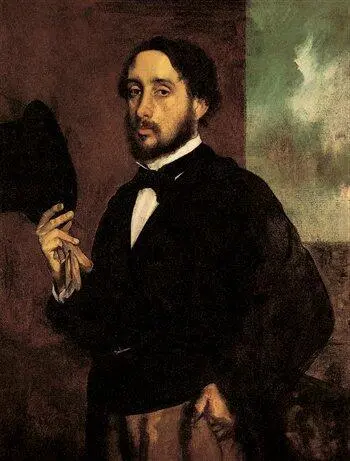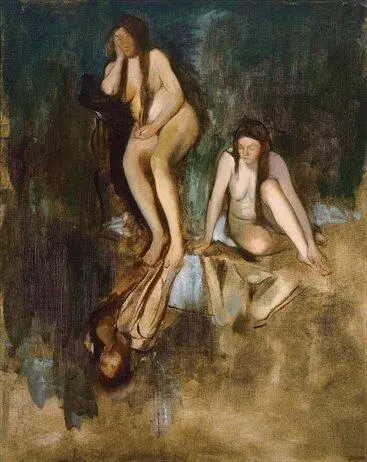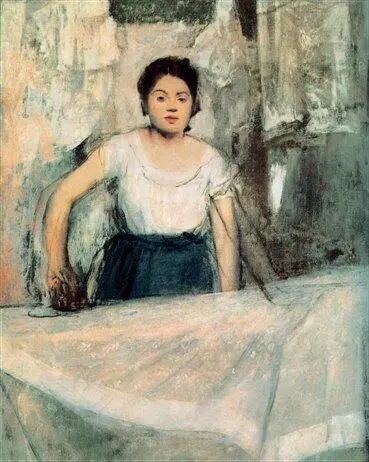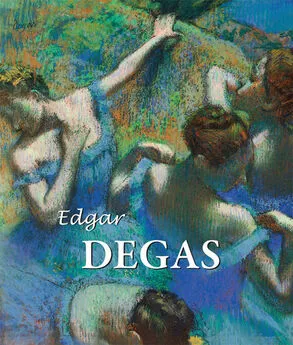Nathalia Brodskaya - Edgar Degas
- Название:Edgar Degas
- Автор:
- Жанр:
- Издательство:Литагент Parkstone International Publishing
- Год:неизвестен
- ISBN:978-1-78310-286-0
- Рейтинг:
- Избранное:Добавить в избранное
-
Отзывы:
-
Ваша оценка:
Nathalia Brodskaya - Edgar Degas краткое содержание
Edgar Degas - читать онлайн бесплатно ознакомительный отрывок
Интервал:
Закладка:
Natalia Brodskaïa
Edgar Degas
© Confidential Concepts, worldwide, USA
© Parkstone Press International, New York, USA


Self-Portrait Saluting, 1865.
Oil on canvas, 92.5 × 66.5 cm.
Museu Calouste Gulbenkian, Lisbon.
Edgar Degas and his works

Young Spartans Exercising, c. 1860.
Oil on canvas, 109.5 × 155 cm.
The National Gallery, London.
Edgar Degas was closest to Pierre-Auguste Renoir in the Impressionist’s circle, for both favoured the animated Parisian life of their day as a motif in their paintings. Degas did not attend Charles Gleyre’s studio; most likely he first met the future Impressionists at the Café Guerbois. It is not known exactly where he met Édouard Manet. Perhaps they were introduced to one another by a mutual friend, the engraver Félix Bracquemond, or perhaps Manet, struck by Degas’ audacity, first spoke to him at the Louvre in 1862. Two months after meeting the Impressionists, Degas exhibited his canvases with Claude Monet’s group, and became one of the most loyal of the Impressionists: not only did he contribute works to each of their exhibitions except the seventh, he also participated very actively in organising them. All of which is curious, because he was rather distinct from the other Impressionists.
Degas came from a completely different milieu than that of Monet, Renoir, and Alfred Sisley. His grandfather René-Hilaire de Gas, a grain merchant, had been forced to flee from France to Italy in 1793 during the French Revolution. Business prospered for him there. After establishing a bank in Naples, de Gas wed a young girl from a rich Genoan family. Edgar preferred to write his name simply as Degas, although he happily maintained relations with his numerous de Gas relatives in Italy.
Enviably stable by nature, Degas spent his entire life in the neighbourhood where he was born. He scorned and disliked the Left Bank, perhaps because that was where his mother had died. In 1850, Edgar Degas completed his studies at Lycée Louis-le-Grand, and, in 1852, received his degree in law. Because his family was rich, his life as a painter unfolded far more smoothly than for the other Impressionists.
Degas started his apprenticeship in 1853 at the studio of Louis-Ernest Barrias and, beginning in 1854, studied under Louis Lamothe, who revered Jean-Auguste-Dominique Ingres above all others and transmitted his adoration for this master to Edgar Degas. Degas’ father was not opposed to his son’s choice. On the contrary: when, after the death of his wife, he moved to Rue Mondovi, he set up a studio for Edgar on the fourth floor, from which the Place de la Concorde could be seen over the rooftops. Edgar’s father himself was an amateur painter and connoisseur; he introduced his son to his many friends. Among them were Achille Deveria, curator of the Department of Prints and Drawings at the Bibliothèque Nationale, who permitted Edgar to copy from the drawings of the Old Masters: Rembrandt, Dürer, Goya, Holbein. His father also introduced him to his friends in the Valpinçon family of art collectors, at whose home the future painter met the great Ingres. All his life Degas would remember Ingres’ advice as one would remember a prayer: “Draw lines… Lots of lines, whether from memory or from life” (Paul Valéry, Écrits sur l’Art [Writings on Art ], Paris, 1962, p. 187).
Starting in 1854, Degas travelled frequently to Italy: first to Naples, where he made the acquaintance of his numerous cousins, and then to Rome and Florence where he copied tirelessly from the Old Masters. His drawings and sketches already revealed very clear preferences: Raphael, Leonardo da Vinci, Michelangelo, and Andrea Mantegna, but also Benozzo Gozzoli, Ghirlandaio, Titian, Fra Angelico, Uccello, and Botticelli. He went to Orvieto Cathedral specifically to copy from the frescoes of Luca Signorelli, and visited Perugia and Assisi. The pyrotechnics of Italian painting dazzled him. Degas was lucky like no other. One can only marvel at the sensitivity Edgar’s father demonstrated with respect to his son’s vocation, at his insight into his son’s goals, and at the way he was able to encourage the young painter. “You’ve taken a giant step forwards in your art, your drawing is strong, your colour tone is precise,” he wrote his son. “You no longer have anything to worry about, my dear Edgar, you are progressing beautifully. Calm your mind and, with tranquil and sustained effort, stick to the furrow that lies before you without straying. It’s your own – it is no one else’s. Go on working calmly, and keep to this path” (J. Bouret, Degas , Paris, 1987, p. 23).

Scene of War in the Middle Ages (detail), 1865.
Oil on paper, on canvas, 83.5 × 148.5 cm.
Musée d’Orsay, Paris.
In 1855, Degas began to pursue studies at the École des beaux-arts, but did not show any particular zeal for his work. Degas preferred to learn at the museums. As soon as his first vacation arrived, Degas took the opportunity to return to Italy. There, at the Villa Medici, fate brought him into contact with residents of the École des beaux-arts who would become his friends: the painters Léon Bonnat, Henri Fantin-Latour, Élie Delaunay, Gustave Moreau, the sculptors Paul Dubois and Henri Chapu, and the musician Georges Bizet, who had not yet composed Carmen . Their gatherings in the old neighbourhoods of Rome, and the picnics with the beauties of the Italian landscape in the background, would remain impressed on his memory to the end of his life.
In the 1850s, Degas started doing portraits and self-portraits. From the very beginning in Degas’ portraits, one senses an attentive observer of human psychology. In Italy he began to paint portraits of his family members. One of his very first is an admirable portrait of his grandfather, René-Hilaire de Gas , it is reminicent of Titian’s portraits to mind. Its professional quality and Degas’ ease in handling the idiom of classical painting makes it possible to compare it to portraits by Ingres. This canvas foretells a future for the painter as a great portraitist. And he indeed became a remarkable portraitist. During the 1850s Degas began to paint the portraits of members of the Bellelli family, that of his father’s sister, who had married Baron Bellelli. He did composition studies, sketched the baron and his wife, painted his own cousins Giulia and Giovannini, and studied the hands of his subjects. The result was a large painting – 200 by 253 centemetres, and painted in Paris, The Bellelli Family , that recalls the portraits of Hans Holbein, Jean Clouet, or Diego Velázquez. But the sky-blue wallpaper with small white flowers lightens the colour scheme, and gives the painting the cozy, intimate feel of a life of ease. The classical balance of the composition is broken, completely unexpectedly by a single detail: the master of the house, seated with his back to the viewer, turns so spontaneously and with such liveliness towards his wife that, in an instant, the impression of models in the act of posing vanishes. With his solid training in classical principles, the painter is beginning to turn, little by little, towards the modern life which will soon absorb him completely.

Mlle Fiocre in the Ballet “La Source” (detail), 1866–1868.
Oil on canvas, 110.5 × 91.4 cm.
Albright-Knox Art Gallery, Buffalo.

Woman Ironing, c. 1869.
Oil on canvas, 92.5 × 73.5 cm.
Neue Pinakothek, Munich.
The enormous painting The Daughter of Jephthah is full of the influences of different masters, from Nicolas Poussin to Raphael, and Eugène Delacroix. The painting Scene of War from the Middle Ages or The Misfortunes of the City of Orléans , with its baffling subject, could have been drawn from a tale that Degas’ grandfather, who was originally from Orléans, had told him. It reminds one of Delacroix. As early as the 1850s he discovered two absolutely new and unexpected subjects: horses and the ballet. In 1859, the Valpinçon family invited Edgar to spend a few weeks at their estate in Ménil-Hubert-sur-Orne where they had a horse-breeding farm. His eye noted their proportions, the particularities of the horse’s skeleton, and the play of its muscles. After his first rather complex compositions depicting racetracks, Degas learned the art of translating the nobility and elegance of horses, their nervous movements, and the formal beauty of their musculature The Parade ( Racehorses in front of the Tribunes ).
Around the middle of the 1860s Degas made yet another discovery. In 1866, he painted his first composition with ballet as a subject: Mademoiselle Fiocre in the Ballet “La Source“ . Degas frequently attended the Paris Opera, where, in 1866, Eugénie Fiocre often danced The Spring . It’s true that, in this first painting, the ballet itself was not yet depicted. It was more a portrait of the ballet dancer. Mlle Fiocre is seated on stage surrounded by Oriental scenery with a horse at her side. Degas had always been a devotee of the theatre, but from this time on, it would become more and more the focus of his art. It gradually permeated his painting through his portraiture. After Mlle Fiocre, he turned to painting portraits of musicians.
In 1869 he did an admirable portrait of his father with Lorenzo Pagans, the musician: Degas’ Father Listening to Lorenzo Pagans Playing the Guitar . Pagans occupies the foreground, wholly absorbed in his music, a guitar in his hands. In spite of the almost classical construction of the composition and the seemingly static nature of the subjects, there is action in this painting: Pagans is gently strumming and Degas’ father is listening. This becomes a characteristic aspect of Degas’ art. Like Manet and the Impressionists, he rejects subject and literary narrative, but in his own paintings there is always something happening. Also in 1869, Degas painted The Orchestra at the Opera.
At first glance this painting is also just a portrait of musicians. In fact it is a portrait of a whole group of the painter’s friends, whom his imagination has gathered together in the orchestra pit. The faces are painted in close up, they are individualised, they have character, and, above all, they are not posing, but, instead, are engrossed in the music. Before Edgar Degas, nothing like this had ever been done before. Three years later, in 1872, Degas’ first painting devoted solely to the ballet appeared: Le Foyer de la danse à l’Opéra de la rue Le Peletier ( The Dance Foyer at the Opera on the rue Le Peletier ). Degas moved from the theatre on to the rehearsal halls, where the dancers practised and took their lessons. This was how Degas arrived at the second sphere of that immediate, everyday life that was of interest to him. The ballet would remain his passion until the end of his days.
Читать дальшеИнтервал:
Закладка:










